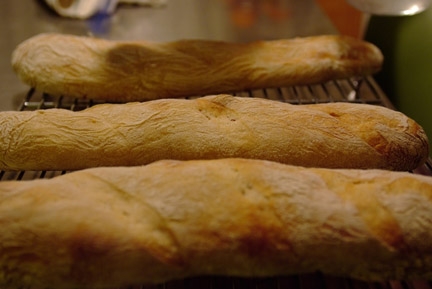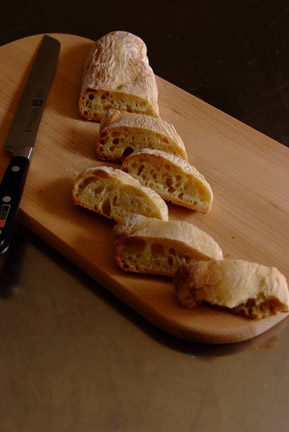And then there’s me. I bake cake. Cookies, too. And brownies. And make candy. Bread, though, was still largely unknown, even with the previous month’s challenge of potato bread. Again, Z. is the bread-baker in our household, I the dessert maker, and we were both content with this division.
When the DB challenge for February was revealed, I wasn’t disappointed, but I knew the optimum world would be challenge. The recipe, from Julia Child’s seminal work on French cooking, is a thirteen-pages treatise. I approached the process with the peculiar combination of curiosity, trepidation and excitement. It was time to bake with the big boys.
Our hosts for the challenge, Mary and Sara, were gracious enough to include many asides and notes throughout the recipe, so I was able to know ahead of time that my little Kitchen Aid Artisan’s 325 watt mixer would be no match for the dough. I was able to immerse myself fully in the mixing and kneading process. Some bakers and cooks love to just get right into their food and mix it with our most primal tool, the hand. I’m not one of those bakers. I find it, well, icky. But in this case, it was an interesting experience to feel the dough change from a heap of flour and water and yeast into an actual dough that was glutinous and alive. The dough, I will note, was extremely wet and rather sticky, but I didn’t want to adulterate it with too much flour and wind up with a tough towel instead of tender bread, so I refrained. After kneading, I placed it into a plastic tub with a lid, which enabled me to see its progress during the rise. It took a while, but once I unsnapped the tub’s lid to let in a little air, the dough rose much faster. This first stage took five hours to get a good rise.
Many more steps, involving deflation, rising, shaping, and yet more rising. None of the steps were particularly difficult, but the amount of time that each required used an entire day. No doubt, a professional bread baker would shudder at my technique, especially when it came to shaping. I wound up with some rather oddly-shaped batards, a few resembling boomerangs and not loaves of bread. Knowing that this was my first attempt at French bread, the benchmark of baking ability, I didn’t concern myself overmuch with the external appearance of the bread. As many a mother has counseled her teenage daughter, it’s what’s inside that counts. Fortunately, my bread wasn’t waiting by the phone, hoping that the cute brioche from calculus would ask it to the dance.
I began the baking process at eleven in the morning. By the time I was sliding the bread into the oven, it was ten at night. Meanwhile, Z. had spent the day also cooking a number of French food, inspired by my bread. Crepes for breakfast (delicious, we had them with various combinations of Nutella, bananas and blackberry jam), then, for dinner, coq au vin, a gratin of potatoes and leeks, and, for dessert, chocolate mousse. (Yes, I am aware that I’m extremely lucky to have him for my husband.) Ironic, then, that my inspirational bread wasn’t even ready to eat to accompany this French feast, even though we ate dinner at the cosmopolitan hour of nine thirty in the evening.
Many more steps, involving deflation, rising, shaping, and yet more rising. None of the steps were particularly difficult, but the amount of time that each required used an entire day. No doubt, a professional bread baker would shudder at my technique, especially when it came to shaping. I wound up with some rather oddly-shaped batards, a few resembling boomerangs and not loaves of bread. Knowing that this was my first attempt at French bread, the benchmark of baking ability, I didn’t concern myself overmuch with the external appearance of the bread. As many a mother has counseled her teenage daughter, it’s what’s inside that counts. Fortunately, my bread wasn’t waiting by the phone, hoping that the cute brioche from calculus would ask it to the dance.
I began the baking process at eleven in the morning. By the time I was sliding the bread into the oven, it was ten at night. Meanwhile, Z. had spent the day also cooking a number of French food, inspired by my bread. Crepes for breakfast (delicious, we had them with various combinations of Nutella, bananas and blackberry jam), then, for dinner, coq au vin, a gratin of potatoes and leeks, and, for dessert, chocolate mousse. (Yes, I am aware that I’m extremely lucky to have him for my husband.) Ironic, then, that my inspirational bread wasn’t even ready to eat to accompany this French feast, even though we ate dinner at the cosmopolitan hour of nine thirty in the evening.
We have a pizza stone, so I baked the bread directly on this, and put a pan of ice cubes in at the same time to attempt to recreate the critical steam oven. I forgot, in my haste, to brush the bread with water before baking, but it was late at night and I was ready to just bake the damned bread already. When it came out, it definitely looked like bread, and smelled like it, but the recipe and our hosts stated explicitly that it had to cool for two to three hours. So, we ate dinner. We had dessert. We watched bizarre VH1 “celebutainment.” We played with the cats. And finally, at midnight, we tried some bread.
The crumb was gorgeous, the flavor pronounced but not yeasty and raw. The epic rises leant the bread a tangy, almost sourdough quality. Ah, maturity! Z. confessed to being jealous of the flavor, having not yet produced it in his own bread baking, but I demurred, citing the more than nine hours of rising time as the key to the bread’s success and not some particular skill of my own. The bread in question was put into the bread bin and we retired for the night, both of us exhausted. He’d been cooking all day and had done the dishes at least five times.
The crumb was gorgeous, the flavor pronounced but not yeasty and raw. The epic rises leant the bread a tangy, almost sourdough quality. Ah, maturity! Z. confessed to being jealous of the flavor, having not yet produced it in his own bread baking, but I demurred, citing the more than nine hours of rising time as the key to the bread’s success and not some particular skill of my own. The bread in question was put into the bread bin and we retired for the night, both of us exhausted. He’d been cooking all day and had done the dishes at least five times.
Breakfast was toasted bread with jam on some pieces, Nutella on some others. We took it to Z.’s mom’s place for lunch, and there weren’t enough leftovers after all that to make a bread pudding, as I had been anticipating. When my mother-in-law tried the bread, she exclaimed, “This is real.” And, indeed it was. Real bread. That I had made. Myself. The food which supported the planet, which shaped nations and defined art. I’d done it. I reveled in my small accomplishment, pleased that I had, in fact, made French bread. It wasn’t pretty, but it was true. And, while I enjoyed the process of its creation, I will never attempt this recipe again. I cede the bread ovens of this globe to stouter souls than mine, who hold in their flour-covered hands the sustenance of the world.
Your servant,
Ami
Your servant,
Ami




7 comments:
Isn't it amazing to work and wait all day and then end up with... real, honest-to-goodnes bread! I also don't think I'll make it again but thought making it once was really cool. Great job!
I love that last picture of your bread. Beautiful.
And I don't think that you necessarily need to brush it with water if you are going to create steam in there some other way, do you?
Great job on your bread!
Thanks for baking with Sara and I
You did a lovely job on your bread!
Natalie @ Gluten A Go Go
I guess waiting all day and then some more was really worth the results you got with the bread.
Well all that work and 13 hours paid off. Your bread looks great
Ami-Next time you have thirteen hours to spare, how about making another loaf of perfect bread and another lemon merangue pie in between risings. My carb/sweet tooth knead both badly. Awaiting your next experiment. P.
Post a Comment